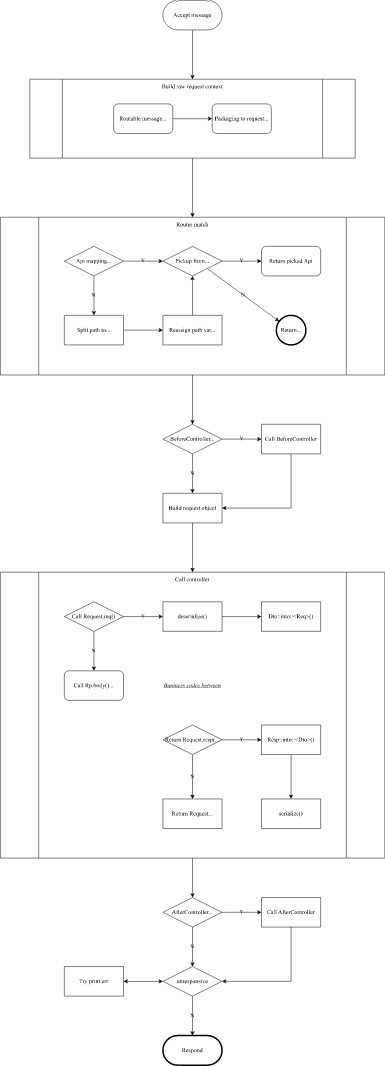3 releases (1 stable)
| 1.0.0 | Jun 28, 2024 |
|---|---|
| 0.2.0 | Mar 7, 2024 |
| 0.1.0 | Feb 29, 2024 |
#987 in Network programming
165 downloads per month
315KB
3.5K
SLoC
Almost all applications provide interactive interfaces. Due to different protocols, there is no unified routing rule for different types of interfaces, which may lead to a chaotic program structure and make it difficult to control various interfaces in a unified and convenient way. To address this issue, DCE provides a standard router and encapsulates the characteristics of routable protocols. For interfaces without standard URI paths, as long as they implement the routable protocol trait, they can be uniformly routed through the DCE router.
DCE-RUST not only encapsulates the main router but also includes a session manager. Together with the router, it enables smooth permission control. Besides basic session storage interfaces, the session manager implements user sessions, long connection sessions, and self-regenerating session managers, facilitating the management of user-level sessions. For more detailed documentation, click here.
The DCE router package is located in crates/router, and examples of routable protocol implementations are located in crates/protocols. The application example code for the DCE router is under the src directory. The directory structure is explained as follows:
[ROOT]
├──assets Resource directory
│ ├──templates HTML and other template directory
├──crates Crate directory
│ ├──macro DCE macro package
│ ├──protocols Routable protocol implementation package directory
│ │ ├──cli CLI routable protocol implementation
│ │ ├──hyper Hyper HTTP routable protocol implementation
│ │ ├──tokio Tokio TCP/UDP routable protocol implementation (this implementation is example code and not recommended for direct use in real projects)
│ │ ├──tokio-tungstenite Tokio Tungstenite WebSocket routable protocol implementation (this implementation is example code and not recommended for direct use in real projects)
│ ├──router DCE router package
│ ├──session DCE session management package
│ ├──util DCE util package
├──src DCE application example code
│ ├──apis Route interface example code
Regarding routable protocol trait, since HTTP and CLI have standard path addresses for routing, these implementations are generally applicable to real projects. For other implementations such as TCP routable protocol, they are currently mainly used as example code because communication protocols like TCP usually define a new business protocol on top, and they do not have a unified standard. Therefore, users need to implement the corresponding routable protocol to adapt to the DCE router.
In addition to basic routing functionality, the DCE router also provides a global controller pre-event/post-event interface, and the Request object provides data conversion and serialization utility interfaces:
- The global controller pre-event interface can perform some pre-processing work, such as global permission control, which is very convenient to do here.
- Data converter, used for conversion between
DTOandENTITY. By self implementing theFrom/Intotraits, operations such as desensitization can be performed on entity data, converting it into a data structure suitable for transmission. - Serialization interface used to encode
DTOfor transmission or parsesequencesintoDTOfor conversion into entity objects. The specific serialization tool is configured through theapimacro.
Routing Performance:
Due to the very short process chain, as it directly calls the controller after matching the API by path, so the performance is very high. For regular path APIs, it directly matches the path from the API hash table, with a time complexity of O(1). For variable path APIs, if there is only one variable in the path, the time complexity is O(n), and if there are multiple variables, it increases exponentially. Therefore, it is recommended to use regular paths, or ensure that the number of variables in variable paths is as small as possible, or ensure that there are as few peer variables as possible to achieve the highest routing performance.
Complete Routing Flowchart:
DCE Router Usage Example:
For more complete examples, please refer to the src directory, and for a more detailed document, click here.
use rand::random;
use serde::Serialize;
use dce_cli::protocol::{CliProtocol, Cli, CliGet};
use dce_macro::{api, openly_err};
use dce_router::router::Router;
use dce_router::serializer::JsonSerializer;
#[tokio::main]
async fn main() {
let router = Router::new().unwrap()
.push(hello)
.push(session)
.ready().unwrap();
CliProtocol::new(1).route(router.clone(), Default::default()).await;
}
/// `cargo run --package dce --bin app -- hello`
/// `cargo run --package dce --bin app -- hello DCE`
#[api("hello/{target?}")]
pub async fn hello(req: Cli) {
let target = req.param("target")?.get().unwrap_or("RUST").to_owned();
req.raw_resp(format!("Hello {} !", target))
}
/// `cargo run --package dce --bin app -- manager`
/// `cargo run --package dce --bin app -- manager --user DCE`
#[api(serializer = JsonSerializer{})]
pub async fn session(mut req: CliGet<UserDto>) {
let name = req.rp_mut().args_mut().remove("--user").ok_or_else(|| openly_err!(r#"please pass in the "--user" arg"#))?;
let resp = User {
nickname: name.clone(),
gender: if random::<u8>() > 127 { Gender::Female } else { Gender::Male },
name,
cellphone: "+8613344445555".to_owned(),
};
req.resp(resp)
}
#[derive(Serialize)]
pub enum Gender {
Male,
Female,
}
pub struct User {
nickname: String,
gender: Gender,
#[allow(dead_code)]
name: String,
#[allow(dead_code)]
cellphone: String,
}
#[derive(Serialize)]
pub struct UserDto {
nickname: String,
gender: Gender,
}
impl From<User> for UserDto {
fn from(value: User) -> Self {
Self {
nickname: value.nickname,
gender: value.gender,
}
}
}
Dependencies
~11–22MB
~314K SLoC
